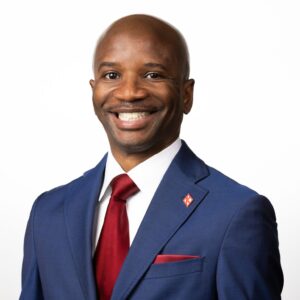How SAS’ PR Lead Danielle Bates turns complex topics into compelling stories
SAS’ global PR & integrated communications lead for financial services shares timeless writing tips.

Danielle Bates, global PR & integrated communications lead for financial services at SAS, drives media strategy and storytelling across banking, insurance, risk, fraud and compliance—helping turn complex topics into compelling narratives. Bates is passionate about amplifying expert voices, building strong collaborations and making sure the right stories reach the right audiences around the globe.
Danielle is a guest speaker for Ragan’s Writing Certificate Course, where she’ll share real-world insights on writing fundamentals and storytelling strategies.
In your role at SAS, what’s your go-to online tool or app that you can’t write without?
Among the online tools I have bookmarked, WordHippo is my (almost-)can’t-write-without-it favorite. There are many online thesauruses, but I haven’t found one as nuanced and deep as WordHippo. I keep it open in a browser window while writing or editing.
More than synonyms, WordHippo offers a variety of word tools – antonyms, definitions and rhymes to name a few. Need to check the plural of “octopus”? Or find other words that start with “oct” or end in “pus”? (Cattywampus, anyone?)
WordHippo is a great resource for anyone in a communications role. (Yes, I’m currently resisting the urge to use it to find an alternative for “great.”)
How do you turn something as complex as risk and compliance into a compelling story?
Risk and compliance isn’t a “sexy” topic. But sometimes, circumstances align with preparation. When a well-regarded US bank fails in 24 hours, suddenly everyone wants to understand why and how. That’s where I come in.
When the news cycle centers public attention on something in SAS’ sweet spot, the stories almost place themselves.
For example, when Silicon Valley Bank collapsed, I sourced journalists’ interviews and placed several bylines written by our experts. I also set up my global counterparts to do the same by assembling expertise and messaging to help them land coverage in their regions.
Of course, current events and trends aren’t always aligned to the stories we want to tell.
Making a topic compelling is all about knowing your audience—or audiences. The way I pitch scenario analysis will differ for an editor at GARP vs. a Forbes contributor. What’s going to resonate with the outlet’s readers?
Working with thought leaders who make complex topics interesting and easy to grasp is another key strategy. I’m lucky in that regard, with access to SAS executives, industry experts, partners, and customers—all with stories to share.
At the end of the day, it’s not the technology that’s compelling; it’s the people and what they’re doing with it. What challenges are they facing? How is technology helping them overcome those challenges? What lessons have they learned? What results have they achieved? Now that’s compelling!
What’s one lesson about writing for a global audience that surprised you?
The summer news slowdown in July and August, when people in many European countries take lengthy vacations, isn’t something I ever experienced before working at SAS.
If you could give your younger communicator self one piece of writing advice, what would it be?
Whatever the deliverable, it will never write itself. Just get started!
This advice is for my current self, too, by the way. Decades in communication, and I still find few things more daunting than the blank page.
The first draft doesn’t have to be perfect. It doesn’t even have to be complete. Writing is rewriting. Get something on the page, and then you can add, edit and polish until it’s good enough to call finished.
That’s a fine line, too. The perfectionist in me likes to flirt with the law of diminishing returns. Writing can always be improved upon. You have to know when to stop.
What’s a recent writing or PR project you’re especially proud of—and what made it click?
That’s a surprisingly tough question to answer. So much of what I write or contribute to is attributed to someone else. I laugh when I tell my kids I’m a well-published writer; they’d just never know since my name isn’t on most of it.
Forced to pick, I’d point to one of our recent global, cross-industry survey reports. SAS debuted the third edition of its biennial Anti-Fraud Technology Benchmarking Report last year. I helped establish this survey-based research initiative with the Association of Certified Fraud Examiners (ACFE) in 2019.
It was the first SAS study enhanced with an online data dashboard, allowing users to explore the data for themselves – a data democratization strategy very on-brand for SAS. For the first time, our global PR leads could easily filter survey data and regionalize their news announcements and pitches with country-specific metrics.
The strategy has helped fuel the placement of hundreds of articles worldwide since the study’s inception, and it’s become a standard practice with other cornerstone SAS survey reports.
I like to experiment with new approaches with each iteration of the anti-fraud tech study. With the latest release, I enriched our visual storytelling with a highlight video developed in PlayPlay with the help of a very talented mentee. I enjoy collaboration, and it’s rewarding to see how our multimedia assets are creatively reused beyond PR and social media promotions for even greater storytelling impact.
What’s one word or phrase you think is overused in corporate comms… and what would you replace it with?
While not specific to corporate comms, “utilize” always gives me pause. As they say, why use a fifty-cent word when a five-cent word will do? Ninety-nine times out of 100, “use” is the more appropriate choice. Simplicity over complexity.
Don’t miss Danielle’s insights on writing fundamentals and how she turns complex topics into clear, compelling stories at Ragan’s Virtual Writing Certificate Course for Communicators on April 16, 23 & 30. Enroll now.
Isis Simpson-Mersha is a conference producer/ reporter for Ragan. Follow her on LinkedIn.







